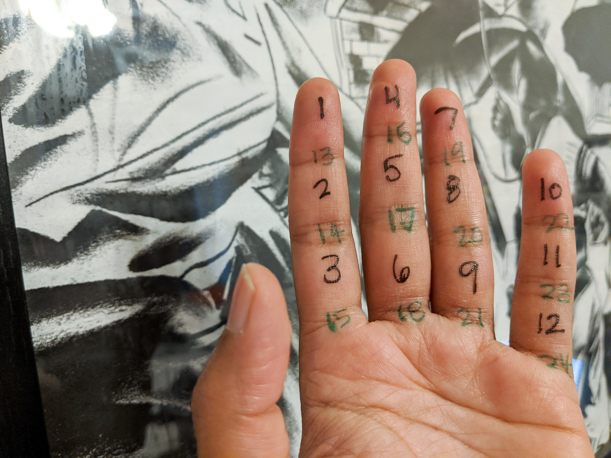BOOMbox at Home: Number Activities
June 30, 2020

Math is everywhere, and once you start seeing it all around you it’s hard to stop! This week, we're sharing videos, activities, and stories showing hidden math in our environments.
Counting
Did you count anything today? How often do you count in your daily life? We count every day and probably many times in a day, but have you ever wondered when humans started to count?
Evidence suggests that people have been counting for about 50,000 years. Ancient cultures used counting to document the number of people in a group, crops, livestock, and artisan goods. Interested in learning more? Watch this brief history of numerical systems. If you’re not sold on the base 10 system, this article presents 12 number systems from other languages. And, many have built strong cases for moving away from base 10 to other number systems, particularly the base 12 system.
Do you like to count aloud? Do you use tally marks? Counting can take place in many languages--nonverbally and verbally. When we first learn to count, we might rely on finger counting, which might have actually been the first known method of counting. This is said to have evolved into sign language, also known as body counting.
We rely on counting so much in our daily lives. One important use of counting is the United States Census. In this case, counting is used to shape the future of communities across the country by deciding where to build new schools, new roads, and new clinics. Here’s a singalong video describing the importance of the census for early elementary grades and home and distance learning activities for all grades. We also recommend a toy census activity from our Youth Services team.
Infinity
What’s the biggest number you can think of? One thousand? Four million? Nine quadrillion?
You’ll probably need a lot of paper to write out your giant number. If your giant number was the number of cookies you had, you’d need a very very big cookie jar to store them all!
But now that you’ve thought about a giant number, can you think of a number bigger than that? Here’s a trick--just add one to your number. The new number is only a little bit bigger than your first number, but it’s still bigger! When you use the idea of infinity, there’s nothing stopping you from having just one more cookie.
Mathematicians spend an infinite amount of time thinking about infinity, because the more you think about infinity, the bigger infinity gets.
Countless Crafting
Counting up to infinity using numbers would take literally forever. Instead, why don’t we use art to think about infinity as an idea?
Try placing two mirrors opposite each other. If you put your hand between the mirrors, how many hands can you see reflected inside the mirrors? This is just one way you can think about infinity.
How would you depict infinity? You can use anything you have on hand, like a pencil and paper or construction paper and sticky tape.
Here are some ideas:
In ancient times, infinity was drawn as an ouroboros. You can think of an ouroboros as the number 8 turned on its side or a reptile swallowing its own tail.
MC Escher draws infinity using stairs that go nowhere.
The Droste Effect is where a picture occurs within itself, and it keeps going.
You can use the one-point perspective technique to draw roads that never end.
Artist of the Week
Yayoi Kusama is a Japanese artist who uses paintings, sculptures, performances, and installations to create colorful artwork with lots of polka dots. In her “Infinity Mirrors” exhibition, she surrounds an entire room with mirrors to make you feel like you are surrounded by an infinite number of polka dots. Yayoi Kusama designed the Wndr Museum in Chicago that included an Infinity Room exhibit with mirrors and mirrored balls.
Share
We’d love to see the results of your experiments! Tag @skokielibrary when you share photos of what you’ve created on social media.
Written by Michelle and Veena.